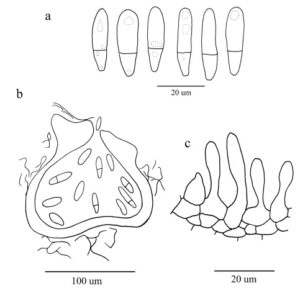Apiocarpella Syd. & P. Syd., Ann Mycol. 17(1): 43 (1919)
Index Fungorum number: IF 7186, MycoBank number: MB 7186, Facesofungi number: FoF 07114, Fig. 1
Sexual morph: undetermined. Asexual morph: Conidiomata brown, pycnidial, solitary, immersed, unilocular, glabrous, ostiolate. Ostiole circular, centrally located. Conidiomatal wall composed of thin-walled cells of textura prismatica. Conidiophores reduced to conidiogenous cells. Conidiogenous cells hyaline, holoblastic, doliiform to ampulliform, determinate, smooth-walled. Conidia hyaline, clavate, broaden and obtuse at the apex, narrowed and slightly truncate at the base, 1-septate, asymmetrical, smooth-walled, guttulate (Sutton 1980).
Type species – Apiocarpella macrospora (Speg.) Syd. & P. Syd., Ann Mycol. 17(1): 43 (1919)
Notes – Apiocarpella was regarded as a subgeneric taxon of Ascochyta (Mel’nik 1971). However, Ascochyta is polyphyletic, and the species in this genus usually possesses enteroblastic phialidic conidiogenesis, which difers the holoblastic conidiogenesis in Apiocarpella (Sutton 1980). Mel’nik (1971) accepted the generic name for 8 species and extended the range to include species on Gramineae, Leguminosae and Ranunculaceae. Sutton (1980) provided a detailed description and illustration of Apiocarpella. No molecular data is available for this genus. Fresh collections of type species are needed to place Apiocarpella in a natural group.
Distribution – Argentina, USA (Sutton 1980).

Fig. 1. Apiocarpella macrospora (redrawn from Sutton 1980) a Conidia. b Vertical section of conidioma. Conidiogenous cells and developing conidia.
